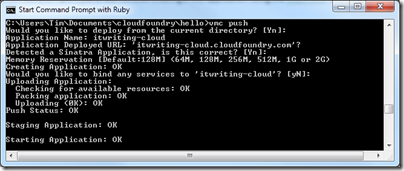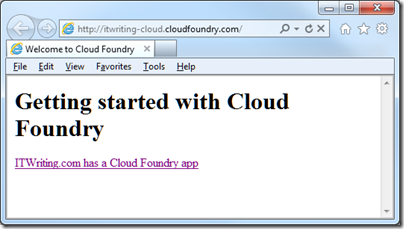I have been meaning to post about VMWare’s Cloud Foundry, a new cloud platform for Spring Java, Ruby on Rails and Node.js applications. Good, incidentally, to see Node.js getting increasing attention – see my post from December when I heard Ryan Dahl present on the subject. I signed up for Cloud Foundry when it was announced, since it has free participation in the current beta.
Today my account went live and I spent just a few minutes creating a first application using the steps here. Well, my first app is indistinguishable from a static web page; but having been immersed in Windows Azure for the last few days, with its accounts and subscriptions and certificates and the portal and the ServiceConfiguration.cscfg and the ServiceDefinition.csdef and all the rest of it, I admit to having a pleasant sense of “is that it?” when deploying the Cloud Foundry app.
I typed a few lines of Ruby code, saved the file to a directory, and then typed vmc push.
Let me add that I like what Microsoft is doing with Azure, and that in combination with Visual Studio it makes an impressive cloud development platform that, from what I have seen, works very well; I think it is of major importance. I also like the fact that Microsoft has pushed down the cost of entry, with its Extra Small instances and more generous offers to MSDN subscribers, partners and others. It easier to experiment a bit with Azure than it used to be.
Nevertheless, Azure lacks the delightful simplicity of getting started that you can see in Cloud Foundry. After doing my Hello World app I look forward to trying something more advanced; and while I am sure that the delightful simplicity soon disappears as the lines of Ruby code increase, and as you try to make your application scalable and transactional and secure and all those good things, the fact that it draws you in is an advantage.

